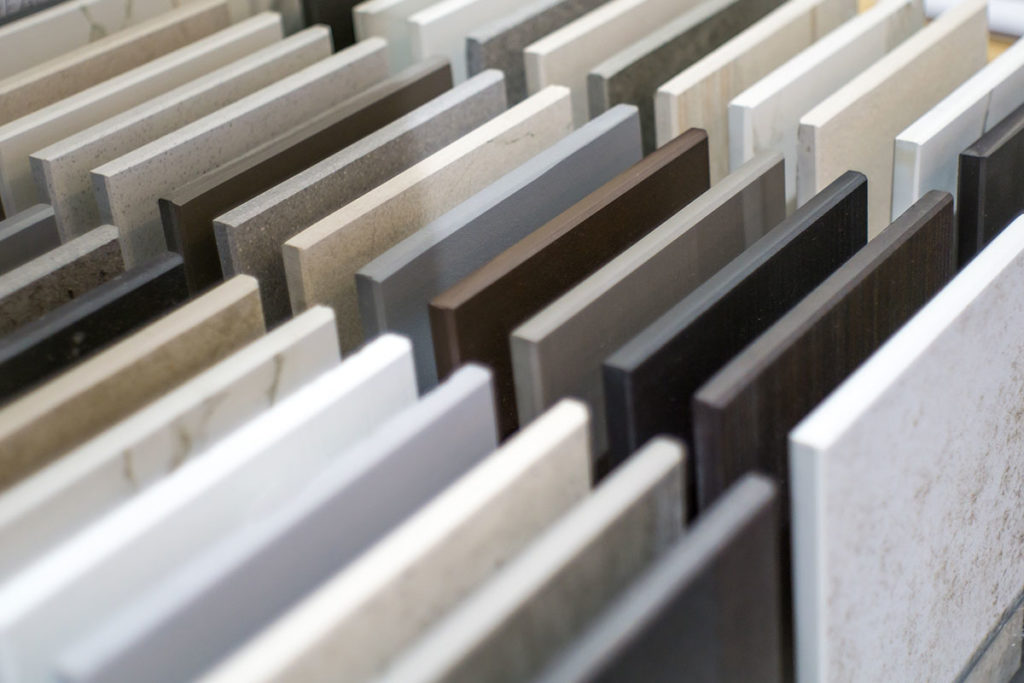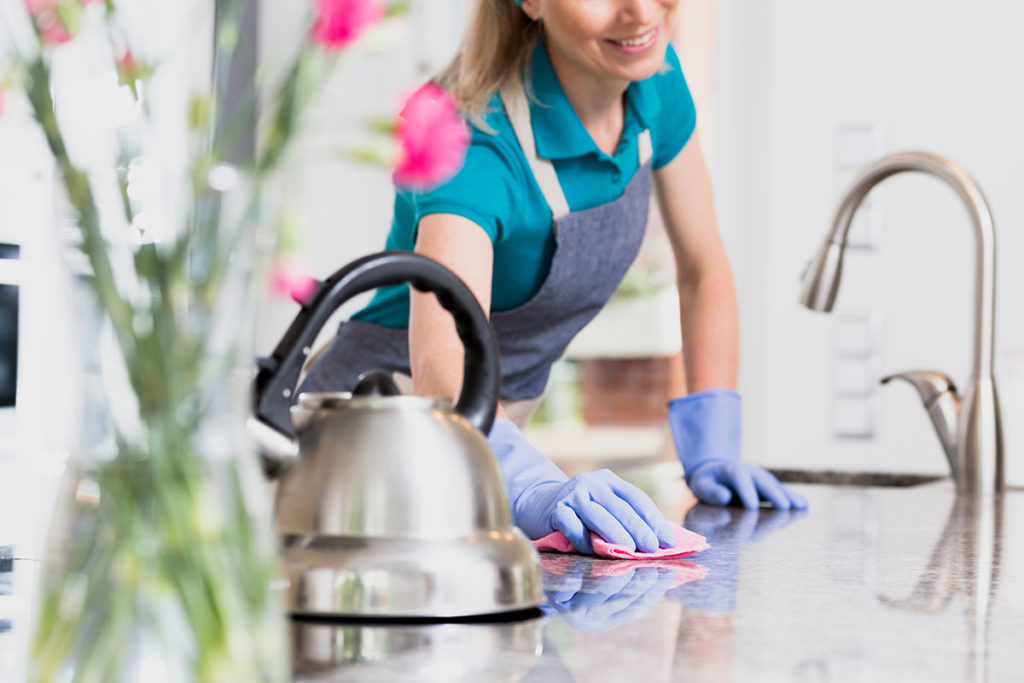The natural stone countertops in your home and commercial buildings both function as a beautiful furniture and investment to increase its overall value. You can extend its functional life and preserve its beauty by observing proper care and maintenance.
Here, we are going to share with you some good insights on how to extend the life of your natural stone countertops. It does not take much technical skills, as long as you read through the article and follow our tips.

Do You Know Your Stone?
Typically, we can classify natural stones into two, that is, Calcareous and Siliceous Stones. Each has their respective traits, benefits, and limitations. Below are some further explanations.
- Calcareous stone – These stones are mainly made from calcium carbonate compounds. They naturally react with acidic solutions like lime juice and vinegar or other acidic cleaning agents. Common examples of this type include travertine, onyx, marble,and limestone.
- Siliceous stone – The main component of these stones are silica, quartz, and similar minerals. They are tougher and easier to clean with slightly acidic cleaning agents. Common examples of under this type include quartzite, granite, slate, sandstone, quartz, bluestone, and brownstone.
Now, let us go over with the specific natural stones in the market.
- Granite – These stones have unique crystal designs and patterns of smaller flecks. Likewise, they have thinner and fewer veinings.
- Marble – They come in plenty of veinings, smooth texture, and various color options.
- Quartzite – These are tough non-porous metamorphic rocks which comes from sandstone. It tends to be more scratch and stain proof than granite. They come in more vibrant colors where the common ones are yellow, red and taupes, while the rare ones are blue and green.
- Soapstone – It is a non-porous metamorphic rock which has taken an uptrend in kitchen countertops. It typically comes in honed or matte finish with its innate silky soft surface. Likewise, it has good conductor abilities and you can use any kinds of cleaning agents on this one.
Know the Present Condition of your Natural Stone
This is an important step because it will also dictate the necessary care and maintenance you will be doing on your natural stone countertops. Below are some guide questions for knowing its present condition.
- Do you see signs of the topical sealer peeling off?
- Are there any staining? What type?
- If you are applying any type of coatings or enhancers, what type and manufacturer is it?
- What type of stone finish do you have on your countertop?
- Do you see any cracks, dents, or uneven surfaces?
Natural Stones Care and Precautions
Below are some general tips for natural stone countertops.
- Avoid placing hot pots and items from stove or burners directly on countertop surface. You can use mats or trivets.
- Placemats can be used for ceramics, china porcelain, silver, and other items that can scratch the surface.
- Use coasters for all your glasses filled with acidic drinks and alcohol.
General Do’s and Don’ts for Cleaning
These are the recommended things to do and avoid when cleaning natural stone countertops. You can share these things with your family members or helper.
- Use stone soap solutions or mild cleaning agents
- After cleaning with soap solution, always rinse with water to remove all cleaning agents that might react over time.
- Avoid blotting spills right away.
- For marble, onyx, limestone, and travertine, never use lemon juice, vinegar, and acidic cleaning solutions on their surfaces. The acidic agent will react with the carbonate compounds of the stone.
- Never use an abrasive cleaner on any natural stone surface.
- Never mix ammonia and bleach when making cleaning solutions. It will create toxic fumes.
Daily Cleaning Steps and Tips
- Apply the cleaning agents in drops only for all types of natural stones. If you apply too much, that will leave a soap film on the surface which leads to streak formations.
- Always use a clean and non-abrasive fabric for wiping
- Never use acidic solutions like lime and vinegar for limestone and marble stones.
- After washing with soap, always rinse with water and wipe dry with a clean non-abrasive cloth.

How to Remove Specific Types of Stains
Natural stone countertops are constantly exposed to different substances which can cause stains on its surface. There are around seven kinds of stains that you need to familiarize on how to safely remove them from your countertops. Below are some cleaning tips and descriptions about each type of stains.
Oil-Based Stains
Examples of this one include cosmetics, vegetable oils, and grease. The typical effect of these stains is darkening your stone’s color tone. To remove these stains, you need to dissolve them in non-polar or slightly polar cleaning agents such as mild detergents, mineral spirits, ammonia, and mild liquid cleanser.
Organic Stains
Examples of these stains include paper food, urine, leavers, tea, coffee, tobacco, fruits and animal poops. These stains will produce slight pink to brownish color on your countertop. For indoor countertops, you can use either 12 percent hydrogen peroxide and ammonia to dissolve and remove the stains.
For outdoor countertops, sunlight and rain will normally clean out the stains.
Inorganic Stains
Mostly, these stains come from metals such as iron rust, bronze, and copper. Your nails, bolts, and nuts are common culprits for this one. They will leave an orange to brownish stain on the surface. Meanwhile, your bronze and copper will leave brown to greenish stain on the surface.
You can remove these metallic stains using a poultice which we will outline how to make it below.
How to Make a Poultice for Stain Removal
The materials you will need for making poultice include kaolin, talc, pulverized chalk, and white molding plaster. Approximately, to clean one square foot of countertop you need one pound of poultice. Some hardware sell premixed poultice which you only need to add water before application.
The other materials you need for making this include paper towels, gauze pads, and cotton balls.
Procedures
- For powder ingredients, you need to mix the cleaning agents until you reach a paste-like thickness and a peanut butter-like viscosity.
- Wet the stained section of your countertop with water.
- Apply around 1/4” to 1/2” thickness of your poultice to the stained area and extend around one inch for area application. You can use a plastic or wood piece to spread the poultice evenly on the stained area.
- Grab a plastic film and cover the area with poultice. Seal off the edges of the plastic film with tape.
- Let it sit and dry for 24 to 48 hours. After drying, remove the tape and plastic. Grab a durable plastic folder and remove the poultice.
- Rinse the stained area with water and wipe dry with a soft cloth.
- You can repeat the procedure if there are stains remaining.
Biological Stains
Examples of these stains include moss, lichens, blood, algae, and mildew. To remove these stains, you can choose any of the following – 12 percent hydrogen peroxide, ammonia, or bleach, and then dilute them in 1/2 cup of water. Never mix bleach and ammonia because it creates toxic fumes.
After washing, always rinse with water and wipe dry with a soft clean fabric.
Ink Stains
Examples of these stains include pen, permanent markers, and inks. For countertops with lighter color, use bleach or hydrogen peroxide. Meanwhile, for darker colored countertops, use acetone or lacquer thinner.
Paint Stains
For small and light paint stains, you can use lacquer thinner for removal or lightly scrape off with blade. However, for heavy paint stains, you need to use paint stripper solutions sold in hardware and stores. Never use acidic cleaning solutions or direct flame in removing heavy paint stains.
Efflorescence
These are the dried mineral salts left when water on countertop surfaces evaporates. They leave a white powdery stain on your natural stone surfaces. You can easily remove this by wiping with a soft clean cloth, dust mop, or using a handheld vacuum cleaner.
How About Etch Marks
Etch marks can be caused by spillovers of acidic solutions or sharp objects scraping off the surface. You can first remove the stain made by the substance. Then you can place marble polishing powder on top of the etched surface. Grab a damp soft cloth and rub the powder onto the surface. You can use a sander for this one and place it on low-speed setting.
For deeper scratches or dents, better call a professional stone polisher and maintenance personnel to resolve this issue.
How About Sealing of Natural Stone Countertops
For natural stones, having a porous feature is normal except for those who are innately non-porous. Sealing process is straightforward but you have to consider the following before starting your sealing maintenance.
- Always read the warranty terms and manufacturer’s guide of the sealant your just bought.
- You need to contact the manufacturer if there are some details you are not sure in the instruction manual.
- Determine how long will the sealant last after applying on your countertop.
- If possible, always stick to one brand of sealant if you have chosen the right one.
Other Factors to be Considered Before Sealing
- The porosity level of your natural stone
- Toughness and density of natural stone
- How frequent will your countertop be exposed to stains?
- What type of finish do you want for your countertop?
- Effects of sealant on the gloss and color of natural stone
- If you have applied resins on your natural stone, what is the possible effect of the sealant?
What Are the Types of Sealants?
Generally, we have two types of sealants in the industry – topical and impregnators. Let us know the difference between the two before you finally reach a good decision.
Topical Sealants
These are the ones applied on the surface to form a protective film against oil, water, and other substances that can spill over the surface. These sealants are commonly made from acrylic, wax, and plastic substances.
Impregnators
In contrast, these sealants penetrate through the pores of natural stones. They are either solvent or water-based solutions that can be both hydrophobic and oleophobic compounds. Sealing can be done by either brushing the solution or submerging the stone into a container filled with impregnator sealants.
Despite having good sealing properties, they still maintain breathability of the stone. They do so by allowing vapor to come out from the mineral pores.
Wrap Up
This is the end of the road for our discussion, and we hope we have made it worthwhile for you guys. There is genuine and unique beauty from natural stone countertops but it needs your proper care and maintenance to make it last longer than its expected lifetime. These stone countertops serves as your beautifier and valuable asset for your home or offices.
If you need any professional help for you care and maintenance requirements for your natural stone countertops, please contact us anytime. We provide premier services at affordable rates. With us, you are ensured of satisfaction guaranteed on all products and services on stone countertops.
Give us a call for your all-in-one natural stone countertop solutions.
